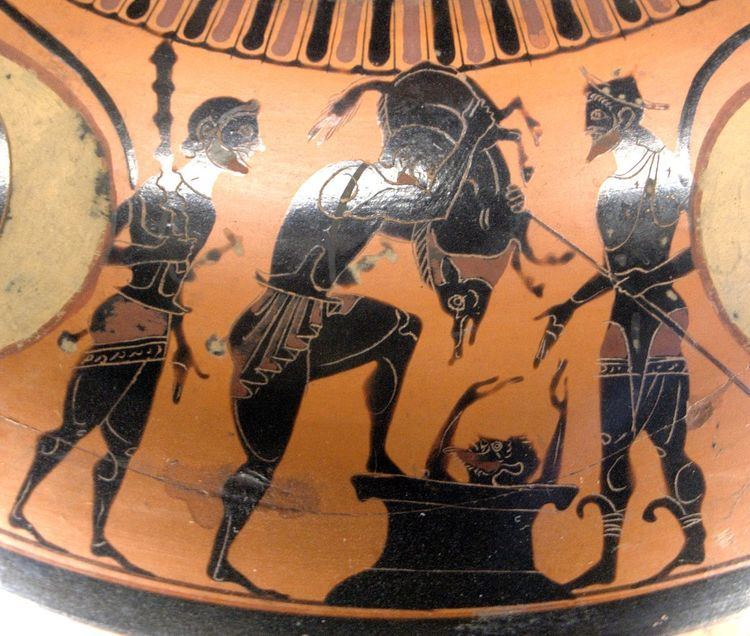Grouping Legendary creature Country Greece | Mythology Greek mythology Habitat Mount Erymanthos | |
 | ||
In Greek mythology, the Erymanthian Boar (Greek: ὁ Ἐρυμάνθιος κάπρος; Latin: aper Erymanthius) is remembered in connection with The Twelve Labours, in which Heracles, the (reconciled) enemy of Hera, visited in turn "all the other sites of the Goddess throughout the world, to conquer every conceivable 'monster' of nature and rededicate the primordial world to its new master, his Olympian father," Zeus.
Contents
Mythology
In the primitive highlands of Arcadia, where old practices lingered, the Erymanthian Boar was a giant fear-inspiring creature of the wilds that lived on Mount Erymanthos, a mountain that was apparently once sacred to the Mistress of the Animals, for in classical times it remained the haunt of Artemis (Homer, Odyssey, VI.105). A boar was a dangerous animal: "When the goddess turned a wrathful countenance upon a country, as in the story of Meleager, she would send a raging boar, which laid waste the farmers' fields." In some accounts, Apollo sent the boar to kill Adonis, a favorite of Aphrodite, as revenge for the goddess blinding Apollo's son Erymanthus when he saw her bathing. Robert Graves suggested that Aphrodite had been substituted for Artemis in this retelling of the mytheme of the eponymous Erymanthus. The most commonly accepted version, however, states that Ares turned himself into a boar and killed Adonis out of jealousy.
The Fourth Labour of Heracles
Heracles' fourth labour—by some counts, for there is no single definitive telling—was to capture the Boar. On the way there, Heracles visited Pholus ("caveman"), a kind and hospitable centaur and old friend. Hercules ate with him in his cavern—though the centaur devoured his meat raw—and asked for wine. Pholus had only one jar of wine, a gift from Dionysus to all the centaurs on Mt. Erymanthos. Heracles convinced him to open it, and the smell attracted the other centaurs. They did not understand that wine needs to be tempered with water, became drunk, and attacked. Heracles shot at them with his poisonous arrows, and the centaurs retreated all the way to Chiron's cave.
Pholus was curious why the arrows caused so much death, and picked one up but dropped it, and the arrow stabbed his foot, poisoning him. One version states that a stray arrow hit Chiron as well, but Chiron was immortal, although he still felt the pain. Chiron's pain was so great, he volunteered to give up his immortality, and take the place of Prometheus, who had been chained in to the top of a mountain to have his liver eaten daily by an eagle, although he was an immortal Titan. Prometheus' torturer, the eagle, continued its torture on Chiron, so Heracles shot it dead with an arrow. It is generally accepted that the tale was meant to show Heracles as being the recipient of Chiron's surrendered immortality. However, this tale contradicts the fact that Chiron later taught Achilles. The tale of the Centaurs sometimes appears in other parts of the twelve labours, as does the freeing of Prometheus.
Heracles had visited Chiron to gain advice on how to catch the boar, and Chiron had told him to drive it into thick snow, which sets this Labour in mid-winter. Having successfully caught the Boar, Heracles bound it and carried it back to Eurystheus, who was frightened of it and ducked down in his half-buried storage pithos, begging Heracles to get rid of the beast, a favourite subject for the vase-painters. Heracles obliged. Roger Lancelyn Green states in his Tales of the Greek Heroes that Heracles threw it in the sea. It then swam to Italy, where its tusks were preserved in the Temple of Apollo at Cumae. Three days later, Eurystheus, still trembling with fear, sent Heracles to clean the Augean stables.
Aside from the boar that killed Adonis, the other most celebrated boar in Greek myth was the Calydonian boar, who was killed by Meleager.
